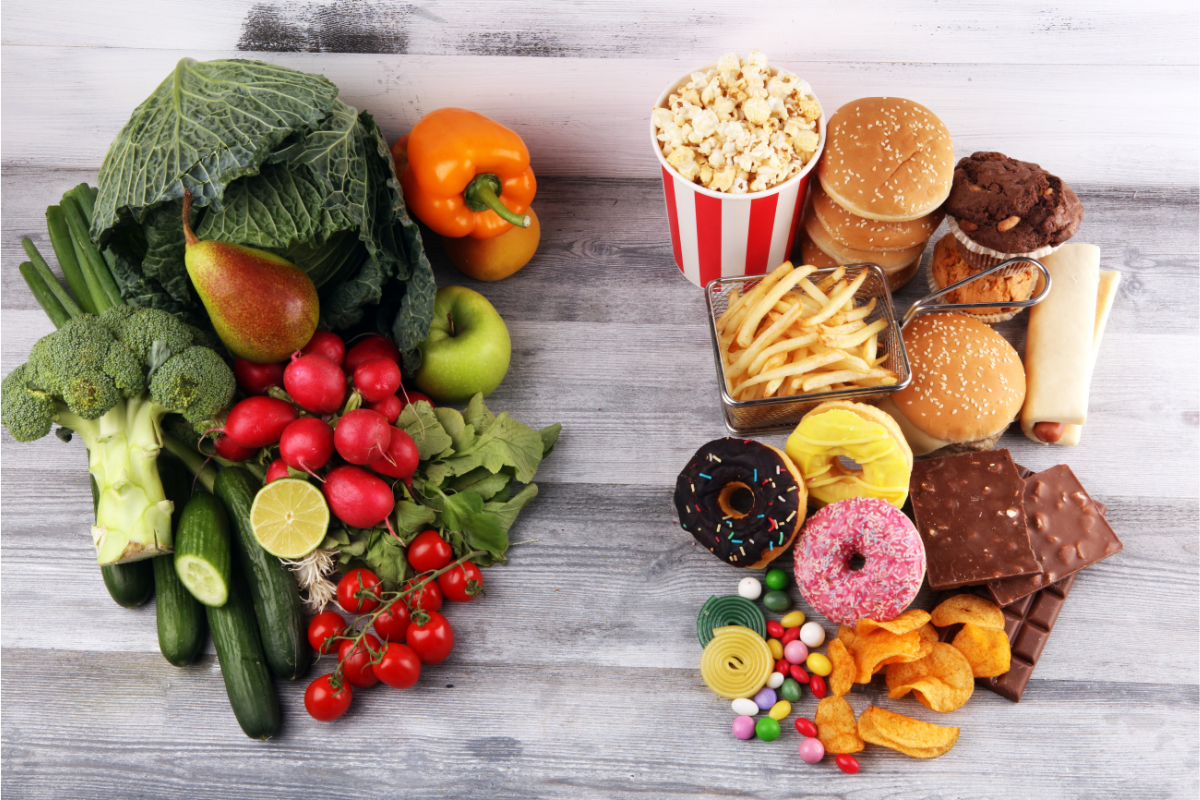We are all surrounded by an abundance of food choices. The landscape of our diets has dramatically shifted over the past few decades, largely due to the forces of globalization. International trade has made once-exotic ingredients commonplace in our local supermarkets. At the same time, the rapid expansion of fast food chains has brought convenient, standardized meals to nearly every corner of the globe.
This proliferation of food options, particularly junk food, has led to a significant change in dietary habits worldwide.
But why, despite knowing the health risks, do many of us still gravitate towards these less nutritious options? The debate between healthy food vs junk food often comes down to taste preferences. Junk food is engineered to be irresistibly delicious, with carefully calibrated combinations of salt, sugar, and fat that light up our brain's pleasure centers. On the other hand, healthy food is sometimes perceived as less appealing, though this perception is often due to our taste buds being accustomed to the intense flavors of processed foods.
As we delve deeper into this comparison, we'll explore the characteristics of both junk and healthy foods, their impacts on our health, and strategies for making better dietary choices. But first, let's get down to the basics: what exactly is junk food?
What is Junk Food?

Junk food refers to items that are high in calories but low in nutritional value. These foods typically have:
- High levels of carbohydrates, sugar, salt, and saturated fat
- Undergone heavy processing, stripping away vital nutrients
- Little to no fiber and water content
Examples include sugary drinks, chips, candies, and most fast food items. While they might satisfy your immediate cravings, they often leave you feeling hungry again soon after.
The processing of junk food often strips away its essential nutrients. For example:
- Refining grains eliminates most of the fiber, vitamins, and minerals by removing the bran and germ.
- High-temperature frying creates harmful compounds like acrylamide and destroys heat-sensitive vitamins.
- While extending shelf life, adding preservatives can reduce the food's nutritional value over time.
Now, let's flip the coin and talk about what makes food actually healthy.
What is Healthy Food?
Healthy food, on the other hand, provides your body with essential nutrients. These include:
- Fresh fruits and vegetables (like apples and leafy greens)
- Whole grains (such as oatmeal and brown rice)
- Lean proteins (including fish and eggs)
- Dairy products
- Healthy fats (like those found in olive oil)
These foods are typically minimally processed and retain their natural nutritional content. For instance:
-
Whole fruits and vegetables aid digestion and help maintain steady blood sugar levels with their fiber content.
-
Unprocessed grains provide more nutrients and promote feelings of fullness by retaining their bran and germ.
- Fresh, lean proteins provide essential amino acids without the added saturated fats that processed meats often contain.
Health Benefits of Healthy Food

Choosing nutritious foods can have a significant impact on your overall health
-
Reduced risk of chronic diseases: A diet rich in fruits, vegetables, and whole grains can lower your risk of cancer, obesity, cardiovascular problems, and diabetes. For example, the antioxidants in berries have been linked to reduced cancer risk, while the fiber in whole grains helps regulate blood sugar.
-
Nutrient-rich: Healthy foods are usually packed with essential vitamins, minerals, and antioxidants that support your body's functions. For instance:
- Vitamin C in citrus fruits boosts immune function
- Iron in leafy greens supports oxygen transport in the blood
-
Calcium in dairy products strengthens bones and teeth
- High in fiber: This aids digestion and helps maintain a healthy gut microbiome. Improved mental health, better immune function, and reduced inflammation throughout the body have all been linked to a healthy gut.
On the flip side, let's not ignore the elephant in the room—the consequences of indulging in too much junk food.
Disadvantages of Junk Food

While junk food might taste good at the moment, it comes with numerous health risks:
-
Nutritional deficiency: Lack of essential nutrients can lead to various health issues, from weak bones to compromised immune function.
- Weight gain and obesity: High-calorie content contributes to excessive weight gain. This leads to deteriorated health and significant health complications.
-
Heart diseases: High levels of saturated and trans fats increase the risk of cardiovascular problems. High trans fat intake is linked to increased LDL (bad) cholesterol and decreased HDL (good) cholesterol.
-
Type II diabetes: Excessive sugar intake can lead to insulin resistance. The World Health Organization reports that sugar-sweetened beverages are associated with an increased risk of type 2 diabetes.
-
Poor digestion: Lack of fiber can cause digestive issues like constipation and bloating.
- Negative impact on mental health: Studies suggest a link between junk food consumption and increased risk of depression. A 2019 study in Molecular Psychiatry found that pro-inflammatory diets high in processed foods were associated with an increased risk of depressive symptoms.
-
Poor dental health: The bacteria in your mouth feed on sugars, producing acid that erodes tooth enamel.
- Addiction and cravings: Junk food can be habit-forming, leading to constant cravings. The combination of sugar, salt, and fat triggers the release of dopamine, creating a cycle of pleasure and craving.
Differences Between Healthy Food and Junk Food
Let's break down the key differences:
| Aspect | Healthy Food | Junk Food |
|---|---|---|
| Energy Density | Low in calories, high in volume | High in calories, low in volume |
| Type of Oil | Healthy oils (olive, sunflower) | Unhealthy fats (butter, lard) |
| Nutrient Value | Nutrient-dense | High in empty calories |
| Ingredients | Natural, minimally processed | Often contains preservatives and additives |
| Fiber Content | High | Low |
| Effect on Blood Sugar | Stable | Rapid spikes and crashes |
| Satiety | Keeps you full longer | Temporary satisfaction, quick return of hunger |
So, what does all this mean for your health in the long run?
Impact on Health
The food choices you make have both immediate and long-term effects on your health:
-
Healthy foods lower the risk of chronic diseases, boost immunity, and promote overall well-being. A study published in the Journal of the American Heart Association found that adults who ate more fruits and vegetables had a lower risk of heart disease and early death.
- Obesity, heart disease, diabetes, and other chronic health issues can result from consuming junk food regularly. The Framingham Heart Study, one of the longest-running studies on cardiovascular health, has consistently found links between poor diet quality and increased risk of heart disease and stroke.
Ever wondered why junk food is so hard to resist? Let's dive into its addictive qualities.
Addictive Qualities of Junk Food
Have you ever wondered why it's so hard to stop at just one chip? Junk food is often designed to be addictive:
-
High sugar and fat content trigger dopamine release, creating a pleasurable sensation that you'll want to experience again. High-sugar milkshakes activated the same brain regions as drug addiction.
-
This can lead to emotional and psychological dependency, where you turn to junk food for comfort or stress relief. The cycle of craving and reward can be similar to that seen in substance abuse,
- The combination of sugar, fat, and salt in many junk foods creates a "flavour profile" that human taste buds find irresistible. Food scientists often refer to this as the "bliss point" - the optimal combination that keeps you coming back for more.
Breaking free from these cravings isn't easy, but here are some practical tips to help you eat less junk food.
Simple Ways to Eat Less Junk Food
Breaking the junk food habit isn't easy, but these strategies can help:
-
Avoid stocking up on junk food at home or work. If it's out of sight, it's out of mind!
-
Be mindful of portions when you do indulge. Use smaller plates or bowls to help control serving sizes.
-
Share junk food items to reduce individual consumption. This can make treats more special and social.
-
Choose healthier options when eating out. Many restaurants now offer nutritious alternatives.
-
Practice meal prepping. Having healthy meals ready to go can reduce the temptation of convenient junk food.
-
Learn to read nutritional labels. Understanding what's in your food can help you make informed choices.
- Find healthy alternatives to your favourite junk foods. For example, try air-popped popcorn instead of chips or frozen fruit instead of ice cream.
And there you have it—simple changes that can make a big difference.
Concluding Thoughts
The healthy food vs junk food debate isn't just about nutrition—it's about making informed choices that balance enjoyment and health. While eliminating junk food might not be realistic for everyone, moderation is key to maintaining a balanced diet.
Understanding the differences between healthy and junk food empowers you to make better choices. It's not about perfection but progress. Small, consistent changes in your diet can lead to significant improvements in your health over time.
Remember, every healthy choice you make is a step towards better health. Whether it's adding more vegetables to your plate, choosing whole grains over refined ones, or being mindful of portion sizes, these decisions add up.
While supplements like Supply6 360 can be helpful in bridging nutritional gaps, they should complement, not replace, a balanced diet rich in whole, nutritious foods. The foundation of good health starts with what's on your plate.
By making informed food choices, you're investing in your long-term health and well-being. Your body will thank you for it!


